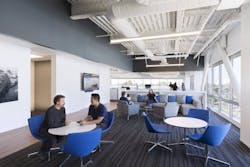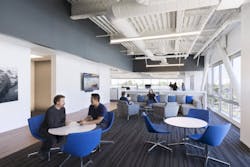The power of office amenities in the workplace
Nothing says “we care about you” more than an employer providing meaningful amenities within the workplace environment. It is no longer enough to attract and retain the best and brightest, C-suite occupiers realize that in order to excel in today’s global economy they must provide a work environment that motivates and inspires the most highly sought after employees. The best companies are all competing for the same talent, and realize they must truly differentiate themselves by leveraging and communicating their authentic culture and vision. Well-designed active and passive amenities are key components of a successful work environment.
With a continued focus on providing “more with less”, companies across all industries are continually driving their workers to increase efficiency and productivity—to get product and services to market faster and cheaper. This push to get more done by fewer staff, while utilizing less square footage, puts increased stress on workers. Longer work hours and ever increasing deadlines add to the challenge of work/life balance. As a result, the workplace environment has become not only a place to work, but a place to innovate, socialize, let off steam, and decompress.
The most successful venues for meaningful employee socialization have important characteristics: activity, change of pace and environment and engaging the senses. Getting people out of their normal work environment, moving around, engaging in wellness activities, bringing in sound and music, offering entertainment and even food, all bring people together and create an enriched environment for socializing within active amenity spaces.
Office amenity spaces are not always located within the immediate office interior design; we have seen proximity to outdoor spaces to be one of the most powerful opportunities for employees to interact, laugh, chat and establish meaningful bonds during breaks in the work day. There is nothing better than taking a walk with coworkers, grabbing a coffee, having lunch outside, getting fresh air, and stretching your legs.
Active interior amenity spaces need to be strategically placed within the work environment to minimize disruption to those working on focused tasks, while being centrally located along primary circulation aisles to attract use by all staff. Daylight and views can provide a change of environment and enhanced experience for those using these amenity spaces. These types of spaces, such as café’s, game lounges, multipurpose collaboration spaces, want to be lively and active, encouraging interaction. Designed by LPA, DPR Construction’s Pasadena office includes a comfortably furnished outdoor space accessible from multiple locations throughout their offices, as well as a wine bar where employees can gather after work with clients and socialize.
Alternatively, passive amenity spaces promote quiet reflection and stress reduction. We see our corporate and institutional clients alike, providing privacy rooms, phone booths, libraries and private study areas within the work environment. California State University, Northridge’s Oasis Wellness Center even includes decompression pods that allows students to take time for themselves to decompress from the stresses of college life.
With the continued shift toward open office plan work environments, companies must plan for private spaces where employees can work quietly, make private calls and take a break from the highly efficient and productive work process. Even the most brilliant, sought-after employees need some down time.

